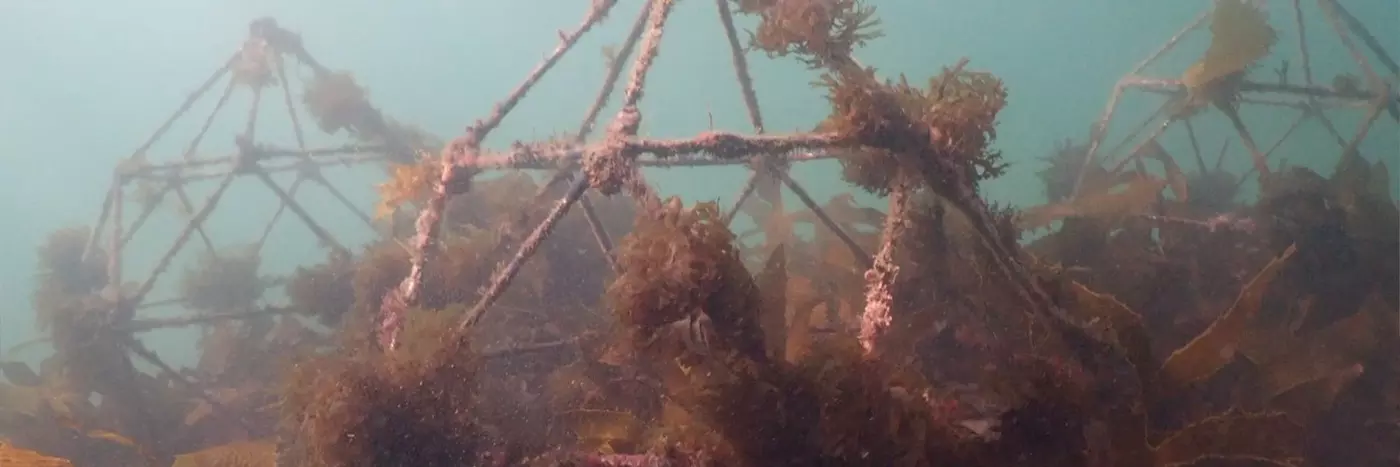How an artificial reef under the Opera House has helped transform Sydney Harbour
This World Oceans Day, meet the diving force behind the Opera House’s underwater revolution.
Ever wondered what looms deep beneath the Opera House and Sydney Harbour? Well, so did we. So, just over two years ago now, we installed a modular artificial reef along the Opera House sea wall. Now, two years on from the initial installation and in celebration of World Oceans Day on June 8 we chat with Professor David Booth and Giglia Beretta, Marine Ecologists at the University of Technology Sydney, to find out how the reef has impacted Sydney Harbour. Plus the two share their findings from a recent survey dive.
Can you give us a brief overview of the artificial reef at the Opera House?
DB: Highly biodiverse harbours such as Sydney Harbour have in fact recorded over 600 species of fish, which is amazing but they still encounter problems. Urbanisation in general but also the built environment, a lot of walls and wharves that have taken away from the original habitat and this area is no exception. The idea of this project was just to see if we could do small enhancements of the areas and maybe attract more small fish and therefore larger fish and biodiversity.
GB: When you think about it, new species of fish were just discovered a few years ago just across the Harbour at Chowder Bay, so we don't know what's actually in places like this. Plus, it's a very unique harbour when you're looking at ‘world scale’.
So tell us about what you're doing today?
DB: Every couple of months we do our surveys. This project has been going on for about three years and for the first half of that we were doing what we call background baseline surveys. We have sites in the Harbour here, we were just looking, doing censuses of the fish species we'd find normally. About a year and a half ago we were able to install these small reefs and the idea is to see against that background and the other sites whether we're seeing any enhancements... Are we seeing different fish? More fish? Any other changes in the behaviour which might indicate these reefs could be useful management tools?
Tell us about what you've seen now that the project has been going for three years.
GB: When we put the reefs in two years ago, there are basically eight reef complexes, where there's three sets of reef in each and since then we've seen a few things like gloomy octopus, we've seen more fish that are sort of aggregating around the area that we wouldn't have seen before, leather jackets for example.
DB: There have been a couple of species which we didn't detect at this site beforehand that have made their home on the reef or are using them to pass through as shelter.
Do these new species indicate anything about the health of the Harbour?
DB: I suppose they do, having travelled around a bit and looked at other highly urbanised harbours it's amazing really in spite of all the pressures to have these amazing array of species just using and this isn't the outer harbour, this is sort of the middle harbour.
GB: It's a very busy working harbour so it's a pretty good indication.
DB: I think it's a good indication that given the correct habitat we can have a really biodiverse harbour.
Have there been any incidents during the diving process that you can share with us?
DB: It's very interesting because, obviously except during Covid, this is a major tourist destination and to be swimming along counting the reefs just off the Opera House and to look up and see maybe hundreds of faces looking back at you is a little bit unusual and unnerving for scientists.
GB: I usually scan their faces to make sure they're not freaking out.
DB: Another advantage of this whole study, apart from the science, is just the outreach. We've never been working in a place where there's such interest in the work and it's because of the Opera House and its stature and global interest. I think it's really brought people on board. Harbours have feelings too.
GB: I think truly people view harbours traditionally as places to dump rubbish and they don’t really think that there is life down there, it's actually quite an important habitat and you know maybe kids will be inspired to carry on.
DB: Well they will be because the Opera House has a linked program on education and there's been really good web facilities for teachers and I know one of our local teachers, a science teacher, has been using it for her class and that's again a potentially global element. And that's another really important part of the study.
What is the significance of World Oceans Day and do you celebrate it?
DB: As marine biologists World Oceans Day is a very important day for us and colleagues all over the world are linked with various events. You can't beat the Opera House as a backdrop for World Oceans Day.
What can people do to mark the occasion? How can they contribute?
GB: There'll be lots of local events in various areas so get online and see what's happening in your local area that you could then contribute to. There's a lot of new Citizen Science Projects that are related to the ocean all throughout the world so it's a great opportunity. You don't have to be a scuba diver to be involved in a World Oceans project and everything we do on land ends up affecting coming down waterways into estuaries and then finally out to the ocean. So everyone is connected to the ocean even if you are in the centre of Australia.

